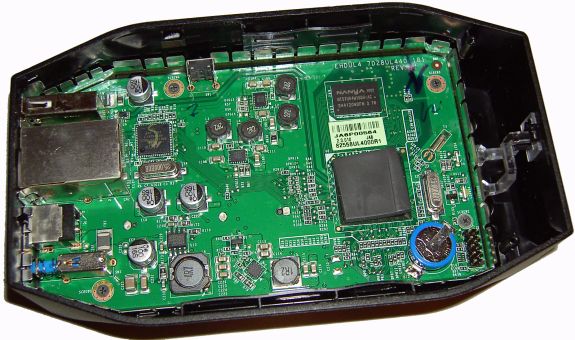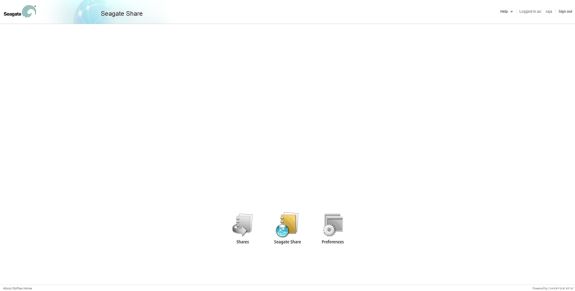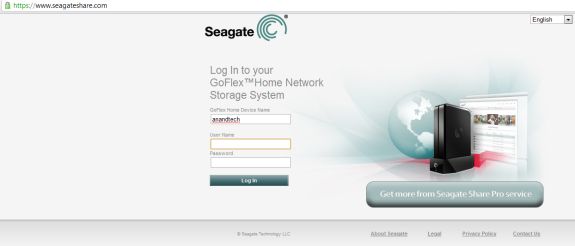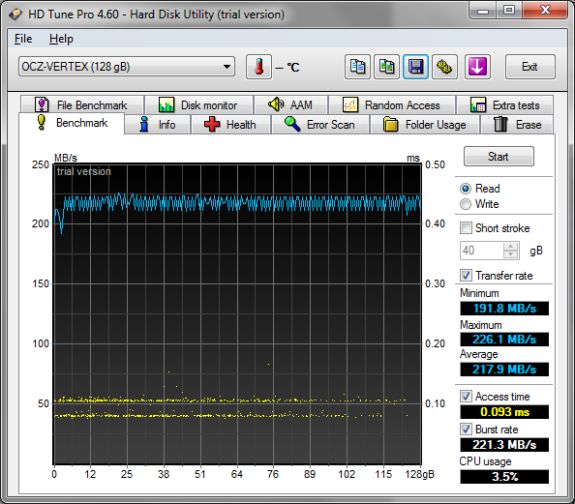
Original Link: https://www.anandtech.com/show/3955/seagate-go-flex-home-2tb-reviewed
Seagate GoFlex Home 2TB Reviewed
by Rajinder Gill on October 10, 2010 5:05 PM ESTAlong with the 3TB Seagate USB drive Anand reviewed last month, Seagate also sent us a NAS drive based around the same aesthetics – the GoFlex Home 2TB:
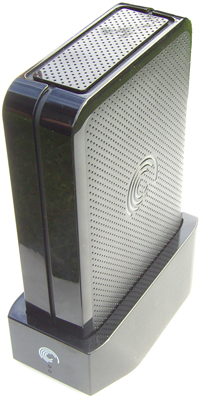
The 2TB GoFlex Home
The GoFlex Home connects via a Gigabit Ethernet port and allows all manner of media streaming, file sharing and backups across a home network or the internet with the key emphasis of Seagate's software bundle being on ease of use. 2TB of space is more than enough space to store a huge library of video and music, and more than ample to be used as a general backup device. The 2TB GoFlex Home retails around $229 - if you can’t see yourself needing that much storage, Seagate offers a 1TB version of Go priced around the $159 mark.
Let's delve staright down into the physcial stuff before we take a gander at the software package...
As with the 3TB GoFlex Desk, we managed to force the casing apart and take a peak at the drive inside:
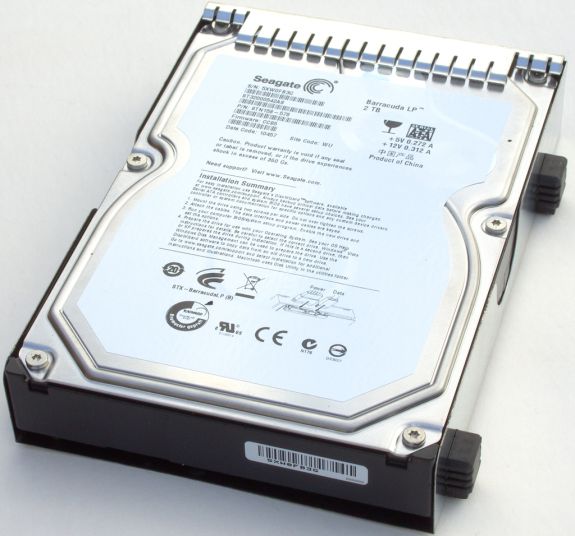
It's a Seagate Barracuda ST32000542AS
Seagate's choice of casing was a stifling blow for the 3TB GoFlex Desk. Hopefully we won't find the same problems on the 2TB Home - we'll be taking a look at temps a little later.
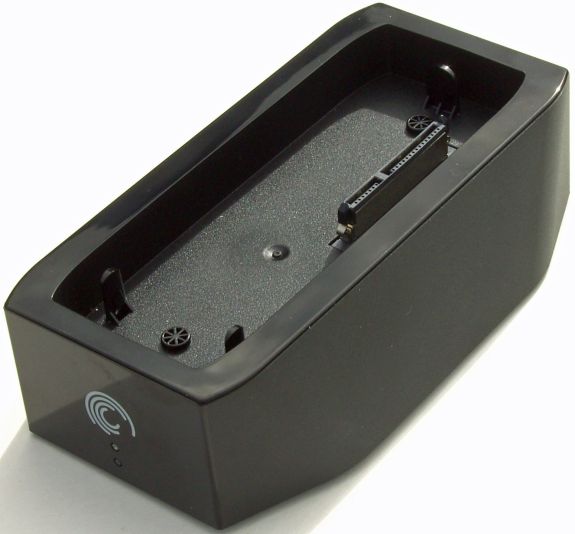
The GoFlex Home docking station
Upgrading or replacing a drive at a later date is possible, although you are limited to using one of Seagate's GoFlex drives. A couple of LEDs grace the front side of the docking unit; one pertaining to connectivity and the other showing drive ready status (drive activity is not shown, unfortuantely). Although we haven't pictured the rear here, a gigabit ethernet port, USB port (for plugging in a network printer or USB drive), on/off switch and power input connectors are all located on the rear of the unit. Power is supplied by a (included) wal-wart 12V PSU.
At the heart of the Go FLexHome is a 1.2GHz Marvell 88F6281 processor (underneath the tthermal pad), teamed up with 128MB of Nanya RAM and also 500MB of flash memory. The Gigabit Ethernet port is driven by a Marvell 88E116R LAN controller.
The GoFlex ships with a driver CD supporting both Microsoft Windows and Apple’s Mac OS. Seagate uses an Axentra based OS with a front end provided by Memeo for software control of the GoFlex drive (we’re testing the Windows version here):
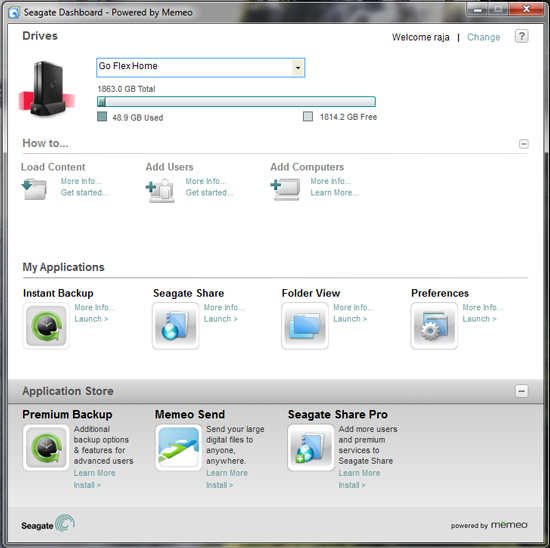
First-time setup is painless, the software will prompt you to setup a master account (mandatory for access), install the Seagate Dashboard user utility to the system tray and then proceed to map three folders to the OS:
 Media/music files placed in the Public folder are available to DLNA/iTunes by default.
Media/music files placed in the Public folder are available to DLNA/iTunes by default.
As soon as the master user account has been created, you're free to upload files to the GoFlex Home. If it's media/music streaming you're after, simply upload files into the Public folder and they'll be available on the network to DLNA and iTunes.
The Dashboard utility is supplied by Memeo, and allows complete/partial system backups, file shares, admin control and also provides a link through to Seagate’s Premium services, which allow an unlimited number of user accounts to be added at a cost of $19.99 per annum - by default only five user accounts can be created although multiple logins per account are allowed. Personally we’d have preferred it if Seagate had allowed the creation of more than five user accounts for “free” considering that we’ve got 2TB of storage on tap here.
Here's a breakdown of the features on offer in the standard and Pro versions of Seagate Share:
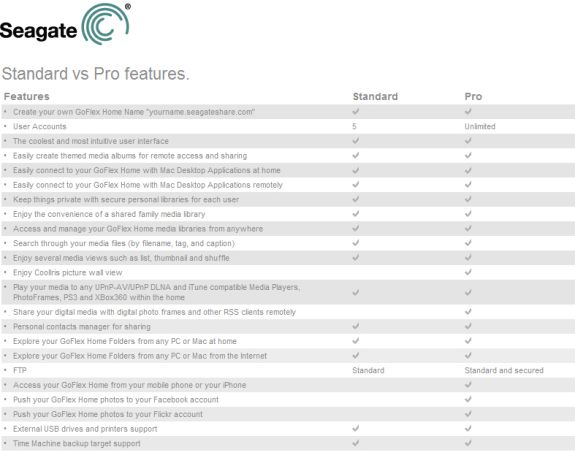
Unlimited user accounts, secure FTP and direct publishing to Facebook and Flickr accounts all come at a price...
Seagate Share
The Seagate Share web utility is accesed via Dashboard and has three options:
Share: access to personal shares (media files, directories that you’ve shared with other users).
Seagate Share: this provides the logged in user with access to the public folder as well as private and backup files under their ownership – from here one can add these to a public share folder (or create a new public share folder) for global access. This section also provides access to any USB drives plugged into the GoFlex base unit.
Preferences: Admin control for user accounts and device settings.
Most of what is needed is available in the admin control section. One thing we don’t like about the GoFlex though is that if you assign a static IP address to the unit, the settings will be lost in the event of a power cycle/power outage. True, most people won’t need to assign a manual DHCP address in a home environment, but one would expect a static IP address to hold if need be.
Remote Access
One of Seagate's key features with the GoFlex Home is that you can access the drive remotely via the internet - WWW.SeagateShare.com. Again it’s all about ease-of-use, provide the drive with a name for recognition and the software takes care of all setup criteria incuding the router for port forwarding to the GoFLex's IP address. Once at WWW.SeagateShare.com, simply enter the drive name and provide user account details, which will log you in and take you to the Seagate share screen (shown above) - it couldn't be simpler.
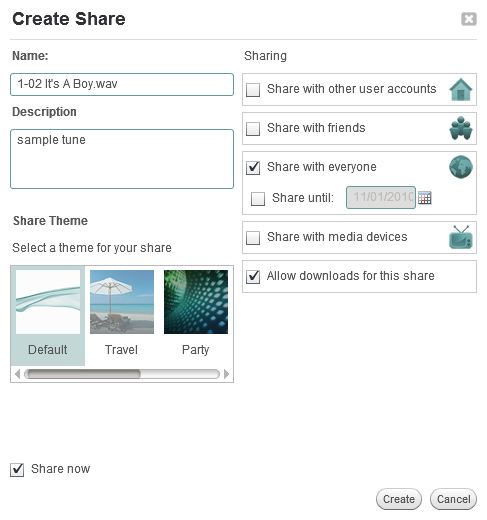
Creating a share is a doddle, the GUI is well laid out and lets you select specific users or media devices to share with. You can also make a global public share that will provide a hyperlink that you can email to friends so that they can view or download files.
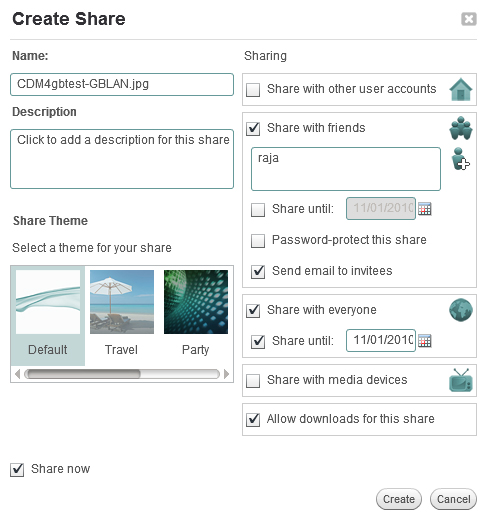
Lastly, there's Memeo Backup, which we've already covered here.
|
Testbed Setup Overclocking / Benchmark Testbed |
|
| Processor | Intel i5-750 CPU - 2.66GHz, 8MB L3 Cache |
| Motherboard | Biostar TPOWER I55 |
| OS Hard Drive | WD 250GB Caviar Black |
| Benchmark Drive | OCZ Vertex 120GB |
| Memory |
CorsairXMS3 CMX8GX3M4A1333C9 DDR3-1333 CAS 9-9-9-24 2GB |
| Video Cards | MSI 275 Lightning (stock clocks) |
| Optical Drives | Plextor PX-B900A, Toshiba SD-H802A |
| Case | LIan Li V-2110 |
| Operating System | Windows 7 64 bit |
| . | |
Our test system consists of Biostar’s TPOWER I55 motherboard, teamed up with an Intel i5-750 Lynnfield processor. We utilized Intel’s NASPTexerciser to benchmark the Go-Flex Home. Windows 7 Ultimate provided the foundation for our test, although we used 2GB of memory as per Intel recommendations to ensure benchmark accuracy (preventing caching of data). A 250GB WD Caviar Black HDD is used for our OS installation, while the NASPT benchmark is run from the OCZ Vertex SSD. We include screenshots of the Vertex's read and write performance below:
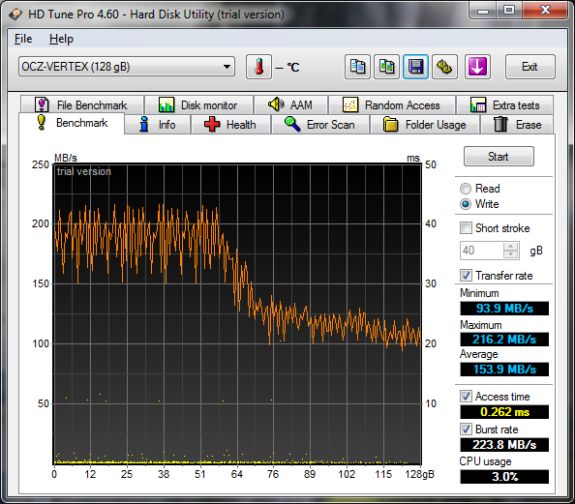
OCZ Vertex 120GB Read and Write Performance.
Our test system should have more than enough bandwidth to highlight potential bottlenecks at the GoFlex end of the line. The network drive is attached directly to the test client machine via the onboard Intel 82578 NIC.
NASPT Benchmark
The NASPT exerciser generates traffic at the file system level using typical user application semantics. The traffic generated emulates actual traces of real applications’ file system requests. We ran the entire benchmark test three times, closing the test suite between runs and opening other software - again, this was done to ensure caching did not skew results.
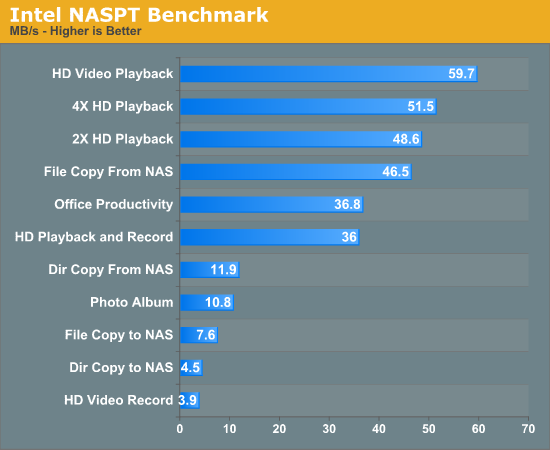
The read based tests seem to fare pretty well, anything involving write operations though, seems to end up sub-par. To confirm a controller/drive level problem we removed the GoFlex from its docking station and attached the drive directly to a SATA port on the test client machine:
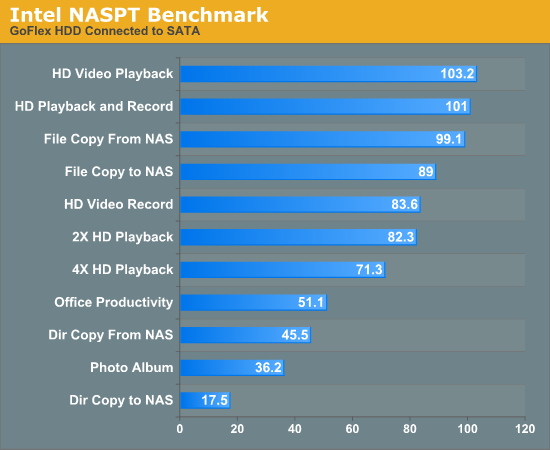
File copy times over the SATA bus see a huge boost over the ethernet~docking station combo. The write bottleneck appears to be a facet of the controller -why the problem exists we're not sure, it obvously means that large file transfers over a network could end up taking painfully long on the GoFlex.
Temperatures
Unfortunately, Seagtate’s bundled software does not include provision for temperature monitoring. Third party SMART monitoring software won’t pick up the drive’s vital statistics via Ethernet ports either. The only way we could get an indication of temperatures was to remove the drive section and plug it into a motherboard via SATA instead. This proved to be a bit of a challenge as the SATA connector is recessed to the extent where we needed to shave the end connector on the cable down for it to fit through the slot in the casing. Here's what we ended up with after a couple of hours of continuous use in an ambient room temperature of 17 Celsius:
| GoFlex 2TB Temperature | |||||
| Idle | Load | ||||
| 34C | 43C | ||||
The end result here is nowhere near as bad as what Anand got from the 3TB unit, although we should be mindful of the fact that we’ve taken the base unit out of the equation here. At a guess the base unit will add another 5~10 Celsius to the temps, bringing us into the fifty Celsius region during sustained use - it's acceptable.
Power Consumption
| GoFlex 2TB Power Consumption | |||||
| Idle | Load | ||||
| 4W | 10W | ||||
We measured power AC consumption of the GoFlex unit at the mains. The GoFlex goes into Idle mode after abour 30 minutes of inactivity, at which point the power consumption will drop to around 4W. A "full load" power draw of 10W is fine for a network drive of this size.
Final Words
If you're looking for a plug-and-play NAS drive, the 2TB GoFlex certainly has its appeal. Unlike the 3TB USB drive that Anand reviewed last month though, Seagate aren’t the only players in the segment as there are other 2TB network drive options out there at a similar price ($200~$230). Most of the paper specs are largely similar, leaving things down to certain aspects of performance, bundled software, user interface flexibility and upgradeability.
The GoFlex Home manages to tick most of the software and ease of use boxes, and even has a window of opportunity for drive replacements and "upgrades" (if one outgrows 2TB of storage). The caveat with the replacements/upgradability being that you're tied to using a GoFlex unit due to the propietary mating mechanism of the drive and base unit. That being said, standalone single drive units like these from other vendors aren't known for offering such options at all, so Seagate manage to do enough to obtain a small lead even though it's not perfect.
This time round, we're pleased that we don't have to issue a word of caution about operating temperatures like we did on the 3TB GoFlex Desk. The 2TB GoFlex Home seems to operate within the bounds of what we'd deem safe without impacting drive longevity.
Our only major gripe with the GoFlex Home pertain to the rather slow write performance; it's a fraction of the read speed. If you're buying 2TB of network storage you're likely to have a serious amount of data to shift over to the drive at some point - it's not a pleasant experience on the GoFlex. We also think that the 2TB version of the drive should offer the ability to create an unlimited number of user accounts as standard rather than asking users to fork out a $19.99 per annum subscription for the privelage.
Unfortuantely, we have yet to test similar sized NAS drives from other vendors so can't say for certain if or how far the GoFlex's write performance lags behind the competition - we're trying to get more samples in so that we can make a more informed conclusion. For now, we'll finish off by saying that if you can put up with the slow write performance (or if time is not of the essence), the GoFlex Home has plenty going for it as an easy-to-use network drive that will get the job done.

